Editorial: Save the Quakers!
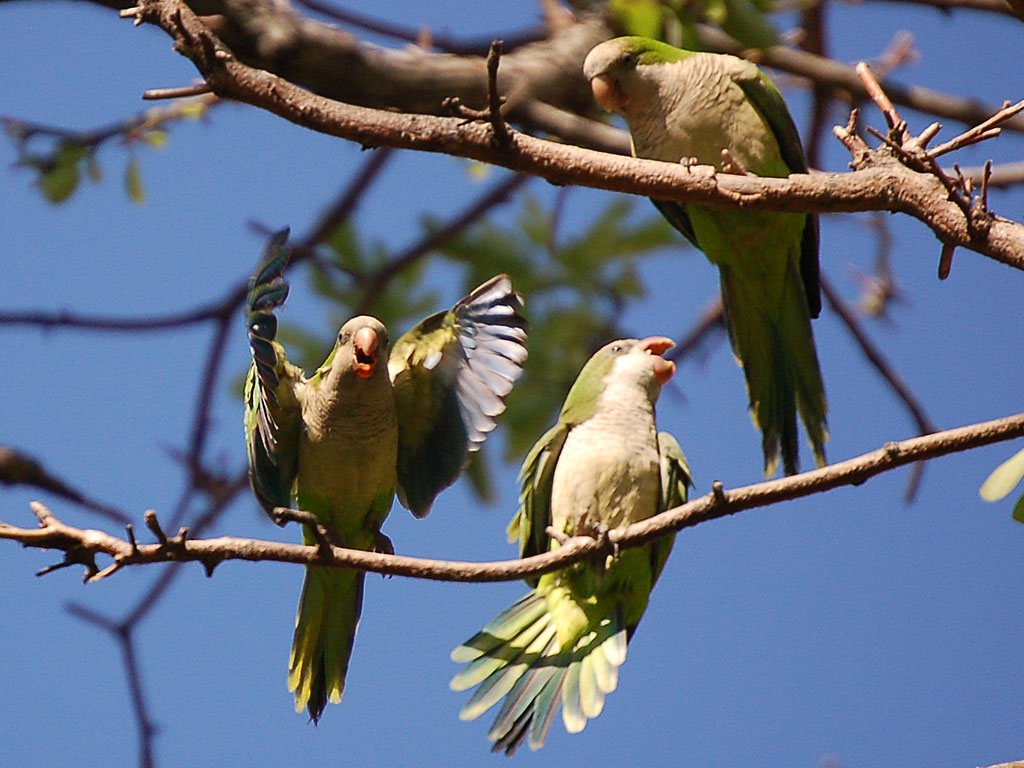
I have been a Friend since 1979, and until recently, I thought I was fairly knowledgeable about Quakers. But what I didn't know was that there are Quakers who hail originally from Argentina, live in extended families, are appropriately friendly, are by preference vegan (!), wear gray but usually also green and sometimes yellow and touches of blue, and are more given to talking than to silence. They also have wings, beaks, and tails, and are variously referred to as Quaker Parrots, Monk Parrots, Quaker Parakeets, or Grey-Breasted Parakeets. Their (human) friends often call them just Quakers.
Where the Heart Is
Because Quakers originally come from a temperate climate with cold winters, Quakers' nests are built not only for incubating and raising their young in the spring, but also for shelter year-round, especially in cold weather. These are architecturally-complex communal dwellings with numbers of round entrances and exits, perhaps like an airborne Brandy Hall, the many-tunneled dwelling where several generations of Brandybuck hobbits in The Lord of the Rings lived in (comparative) peace together.
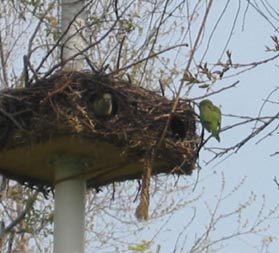 These avian Quakers came to my attention via a mailing from In Defense of Animals (IDA). Matt Rossell, an IDA coordinator, is involved with other advocates in an effort to save a community of Quakers near the little logging town of Yacolt, Washington. Quakers find the top of utility poles to be good places for nest-building, a practice that unfortunately can lead to power outages and electrical fires. From the viewpoint of Clark Public Utilities (CPU), they were nothing but a danger to the (human) public's safety and comfort. One night last November, the CPU destroyed one of the Quakers' homes and killed three of the residents; the others escaped. According to local activist Nick Peck, a great deal of bad publicity resulted from this act, and CPU has been consulting with Yacolt activists and city authorities to work out a solution. Some of these activists have been providing the homeless parrots with food, and are making platforms not far from the original site, on which the Quakers can build new nests. Outside activists got involved; some offered helpful plans, whereas others, by attacking the CPU with hate e-mail, have made matters more difficult.
These avian Quakers came to my attention via a mailing from In Defense of Animals (IDA). Matt Rossell, an IDA coordinator, is involved with other advocates in an effort to save a community of Quakers near the little logging town of Yacolt, Washington. Quakers find the top of utility poles to be good places for nest-building, a practice that unfortunately can lead to power outages and electrical fires. From the viewpoint of Clark Public Utilities (CPU), they were nothing but a danger to the (human) public's safety and comfort. One night last November, the CPU destroyed one of the Quakers' homes and killed three of the residents; the others escaped. According to local activist Nick Peck, a great deal of bad publicity resulted from this act, and CPU has been consulting with Yacolt activists and city authorities to work out a solution. Some of these activists have been providing the homeless parrots with food, and are making platforms not far from the original site, on which the Quakers can build new nests. Outside activists got involved; some offered helpful plans, whereas others, by attacking the CPU with hate e-mail, have made matters more difficult.
The View From "Below"
We of the Animal Kinship Committee, sponsors of The Peaceable Table, are committed to "taking the view from below," i.e., putting ourselves in the place of our animal cousins who are under the human boot, and speaking on their behalf. (In the case of Quaker parrots, the view from below may literally be the view from atop the electrical power pole, but the vulnerability of the animal victims is the same.) We have gotten into the habit of identifying with all animals, both in their joys and in their suffering. But when a particular species of animal is repeatedly referred to simply by the name of our own religious group, the identification is heightened; the view from below (or above) comes into even sharper focus. The emotional effect of reading about them is, by turns, amusing, surprising, and disturbing.
For example: from two websites I learned that "Quakers are very confident and social . . . . They are known around the world for their exceptional talking ability. . . . Most hand fed Quakers are quite gentle and many make wonderful pets . . . ." "Quakers are known to be extremely good eaters. They thrive on fresh fruits and vegetables . . . . Some Quakers tend to become overweight if allowed to indulge in too many fattening . . . treats, so be sure to offer your Quaker fresh greens, legumes, pasta, and other vegetables as a main food source." (Not such bad advice for Quaker humans, either!) "Quakers are active, inquisitive, mischievous, intelligent, playful, and engaging . . . . Keeping Quakers entertained will keep their minds off inappropriate activities." "Many Quakers sing songs and pick up extensive vocabularies. Most Quakers learn to talk at about six months. They speak quite clearly and use their skills most appropriately." (We try!)
Some of the references were not so amusing. "Quakers . . . . usually are easily available and are, therefore, relatively inexpensive (in the $150 range)." The reader is encouraged to "purchas[e] a handfed, well-socialized baby" for best results. Even more ominous, in some states there are laws against Quakers; Washington is not the only state in which a Quaker (though not illegal there) may find herself avis non grata. Because Quakers living in extended families in the wild not only have a habit of taking over power poles, but may eat crops that humans intend to make money by, they are banned in California, Georgia, Kansas, Kentucky, Hawaii, New Jersey, Pennsylvania (alas!), Tennessee, and Wyoming. Specifically, laws prohibit selling or owning them there. Other states have restrictions on importing or breeding them. In some states, a Quaker seized by the authorities may be "euthanized," i.e., executed, legally murdered. In Connecticut in '05 and '06, many nests were destroyed and many Quakers deliberately killed. Echoes of Boston in the 1660s, and of the martyred Mary Dyer, Marmaduke Stephenson, and William Robinson . . . .
Pet Quakers and Other Animals
Although the Friendly reader is relieved to read that avian Quakers are "mechanically inclined" and thus "able to figure out most cage locks in no time," the idea of oneself being bought and sold, having one's baby taken away and sold, and being put into a cage even part of the time until one is taken out to play with one's owner, is not language to warm the heart. Of course this is not on the same level as the kidnapping of the terrified baby calf from his anguished mother, to be shut up in a cage in darkness until being dragged out to death. Probably most of these pet Quakers are much cherished, and cherish their people. But no human wants to be owned, to be bought and sold or have family members sold away, and few adult humans would want to be pets. Avian Quakers, like their human counterparts, should at least have the option of giving their primary love to a mate and family of their own kind; and they should have a right to their own agendas. Another factor is that a certain percentage of pets of any kind are neglected and/or abused and suffer greatly, something that will appear with any sociological pattern of great power imbalance.
Changing the language--"pet" to "animal companion" or "animal friend" does make a difference, partly because it spotlights the two most troubling aspects of petkeeping as it stands. One is the issue of monetary exchange. One cannot buy a friend; one does not procure a friend by breaking up her or his family. The echoes of slavery are too strong. Furthermore, one does not abuse a friend or neglect essential responsibilities for her or his welfare. True, such things would sometimes still happen even with a widespread acceptance of the new language, but at least the language would tend to curb it rather than allow for it.
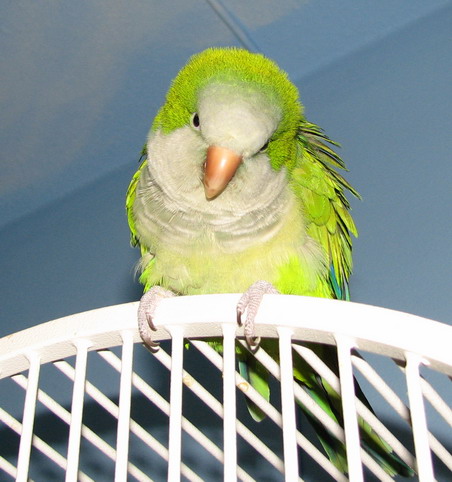 Much as I would enjoy having an avian Quaker to live with me, it will almost surely not happen: because I live in California, because I am not in a position to take in a refugee from a decimated nest, and because I don't want to buy or sell any sentient being, or accept one that has been abducted from her or his family. (A "purchase" that is really ransom from an abusive situation is different.) This is not a rejection of living with animal friends per se, especially in view of the huge numbers, especially of cats and dogs, that are unwanted and unable to provide for themselves in a city setting.
Much as I would enjoy having an avian Quaker to live with me, it will almost surely not happen: because I live in California, because I am not in a position to take in a refugee from a decimated nest, and because I don't want to buy or sell any sentient being, or accept one that has been abducted from her or his family. (A "purchase" that is really ransom from an abusive situation is different.) This is not a rejection of living with animal friends per se, especially in view of the huge numbers, especially of cats and dogs, that are unwanted and unable to provide for themselves in a city setting.
Speaking Up for Quakers and Other Animals
Some activists, who had had a bitter experience dealing with a recalcitrant power company in their own area, responded to Yacolt's situation with hate-mail, as we saw above. Probably all of us know how it feels to share the anguish of innocent beings undergoing violence, to try to change things, and find ourselves blocked. The temptation to give in to verbal violence in return feels overwhelming, and may grow as one encounters similar situations. But just as this response has made the problem in Yacolt harder to solve, it is almost guaranteed to do so anywhere. The fact is that a person who is unthinkingly participating in a cultural evil--whether it is a diner consuming meat or an electrical company employee destroying a nest under a supervisor's instructions--will grow much more defensive under a verbal assault than an approach that assumes they have consciences and are potential allies. It is true that there are people who deaden their consciences, whether approached sympathetically or abrasively. Whatever the case, returning violence for violence is not an option for any of us who seek to open ourselves to the Divine Light within us, and to answer the Light that we believe dwells in every being. The Light is also Love: and only by love, brave and persistent, can the work of Love be done.
--Gracia Fay Ellwood
News Notes
Documentary Planned
Emily W. writes asking for participants to be interviewed for a documentary about vegetarianism to be addressed to the Christian community. She asks:
Are you Christian? Are you a vegetarian?
Did your faith lead you to become a vegetarian?
If so, we would love to hear your story. We are an award-winning documentary production company whose latest project will showcase the Christian vegetarian movement.
We are looking for genuine, thoughtful people who can articulate their beliefs and their lifestyle choices with charm and conviction.
( NOTE – we are also interested in hearing from meat-eaters who are of strong Christian faith & very concerned with the treatment & well-being of animals.
Please email me your name, age, a photo of yourself, your phone number, occupation, city of residence and a brief synopsis of how your faith played a role in your choice to become a vegetarian.
The goal of this film is to support and encourage this movement throughout the Christian community.
Please contact: christianvegetarians@gmail.com
Doreen the Downer: Cartoon Educates About Hamburgers
Due the recent slaughterhouse investigation in a California plant, the abuse that animals raised for food suffer, especially downed ones, reached the public's eyes and, one hopes, their consciences. While most people have a hard time watching graphic videos about animal abuse, it is important to be aware of the reality of factory farming. Cartoonist and animator Mark Fiore has produced a skillful short video, suitable for everyone, showing the way hamburgers are produced, the dangers to human health, and of course the cruelty inflicted on downer animals. To view it, please visit www.sfgate.com/comics/fiore
--Contributed by Lorena Mucke
Christian Vegetarian Association www.christianveg.com
Animal Advocacy on the Rise
Never before in history has the animal advocacy movement gained the level of momentum and supporters it has today. For example, the Humane Society of the United States (HSUS) and the People for the Ethical Treatment of Animals (PETA) have seen their memberships increase substantially: PETA's membership has doubled in the last five years, now reaching 1.8 million, with HSUS having 10.5 million. Animal issues have become part of everyday life: what we eat, how we dress, what courses are taught in universities. To read the full article please visit www.usatoday.com/ news/ nation/ 2008-01-27-animal-activists_N.htm (See also the response by Vasu Murti, from which this issue's Pioneer column is taken.)
While it’s evident that God’s animals are exploited by humanity in greater numbers than ever before, it is also clear that more and more concerned people are taking a stand for these victims and exposing the callousness of the industries who perpetrate such abuses.
--Contributed by Lorena Mucke
Gems
We clearly rank the practice of hunting and shooting for diversion with vain sports . . . Therefore, being not only accountable for our substance, but also for our time, let our leisure be employed in serving our neighbour and not in distressing the creatures of God for our amusement.
--London Yearly Meeting, 1795. Reprinted in Rules of Discipline, 1834.
Contributed by Marian Hussenbux, Quaker Concern for Animals
quaker-animals.org.uk
Daffodils in the Nursery
Imagine a warm spring day on a small farm in Mississippi. The flowers are in fragrant bloom, and a sow that has free run of the farmyard has just given birth to piglets. Later that day, a glance under the porch where the new babies are resting reveals a wonderful sight. The mother pig has carefully bitten off blossoms to make a bouquet of jonquils, which she has arranged in a bright yellow wreath surrounding the sleeping litter. . . . The woman who wrote to tell me about this barnyard nativity accompanied her letter with a hand-rendered drawing showing a halo of flowers with their stems pointing outward, petals toward the center, piglets nestled snugly in the middle.
--Gary Kowalski
From The Souls of Animals, second edition
Book Review: The Zookeeper's Wife: A War Story.
The Zookeeper's Wife: A War Story. By Diane Ackerman. 2007. New York: Norton. 2007. 368 pages, $24.95.
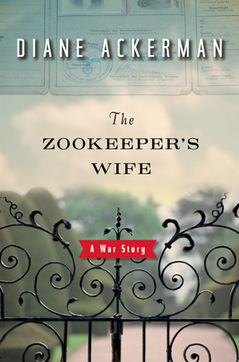 The book is the true story of Antonina Zabinski and Jan Zabinski, who were in charge of the Warsaw Zoo during the horrors of the Second World War. It was a very modern and progressive zoo, with many of the animals in moated habitats instead of cages (this was 1939, thus far in advance of New York's Bronx Zoo in 1961); and the Zabinskis, with a deep interest in animals, were ideal leaders.
The book is the true story of Antonina Zabinski and Jan Zabinski, who were in charge of the Warsaw Zoo during the horrors of the Second World War. It was a very modern and progressive zoo, with many of the animals in moated habitats instead of cages (this was 1939, thus far in advance of New York's Bronx Zoo in 1961); and the Zabinskis, with a deep interest in animals, were ideal leaders.
When the Blitzkrieg came, many of the animals perished from the bombing and shelling. Others-- lions, tigers, polar bears, the male elephant --were shot dead by Polish soldiers, out of fear that if they escaped they would cause death and destruction. (Similar horrors befell the animals in the Zoos of Berlin and Tokyo later in WW II, and in Jerusalem during the 1948 and 1967 wars. In these cases, the zoos, far from being the Arks of Refuge they were supposed to be, became death traps for their inmates.)
The horrors did not end when the Blitzkrieg ended, either. The Nazis moved the capital of Poland from Warsaw to Krakow and decreed that Warsaw, being no longer a national capital, did not need or deserve a zoo. The most valuable animals were shipped off to zoos in various German cities (the rule that only the capital should have a zoo did not apply to the conquering nation) and the remaining ones were killed by the Nazis in what is best described as a pogrom against animals. Worse yet, the now virtually empty zoo became first a pig farm, then a fur-animal farm: two of the most horrible examples of cruel exploitation of animals by inhuman humans.
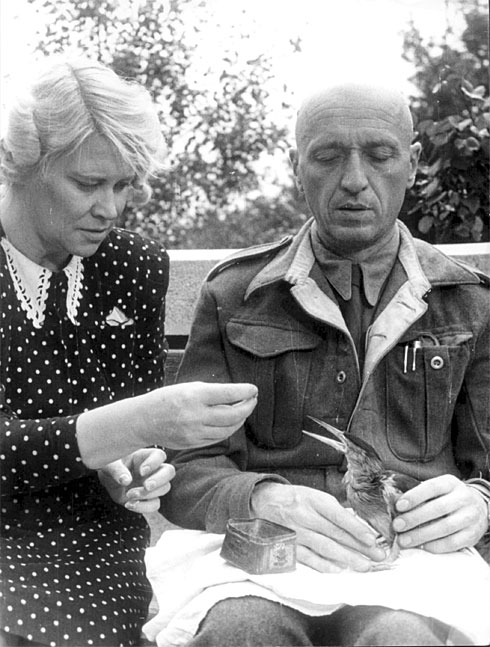 The Zabinskis courageously joined the Resistance against the genocidal invaders, carrying out and assisting acts of compassion and of sabotage. They did what they could to help ease the great suffering of the people in the Warsaw Ghetto: hundreds of thousands cruelly overcrowded into a small portion of the city, and systematically deprived of necessities. They helped about three hundred of them escape (one out of every thousand prisoners), offering some a temporary shelter in the zoo. About a handful of these daring escapes are detailed in the book. Some Ghetto stories are told that really have no connection with the Zabinskis or the zoo, such as the narrative of Dr. Janusz Korczak and the Republic of Children, which nobody with any humanity could hear or read without weeping. But the bulk of the book, as the title suggests, consists of well-told zoo stories that are both fascinating and touching.
The Zabinskis courageously joined the Resistance against the genocidal invaders, carrying out and assisting acts of compassion and of sabotage. They did what they could to help ease the great suffering of the people in the Warsaw Ghetto: hundreds of thousands cruelly overcrowded into a small portion of the city, and systematically deprived of necessities. They helped about three hundred of them escape (one out of every thousand prisoners), offering some a temporary shelter in the zoo. About a handful of these daring escapes are detailed in the book. Some Ghetto stories are told that really have no connection with the Zabinskis or the zoo, such as the narrative of Dr. Janusz Korczak and the Republic of Children, which nobody with any humanity could hear or read without weeping. But the bulk of the book, as the title suggests, consists of well-told zoo stories that are both fascinating and touching.
What I find hard to take in this otherwise excellent book is the author's presenting ethologist Konrad Lorenz as a leading National Socialist ideologue. He was nothing of the sort. He wa a good and great man who made one great and bad mistake: he wrote one article courting a Nazi audience, but it completely failed to impress them, as it made no mention of the sacred topic of "Race." The article had little impact.
The Zabinskis endured great suffering as a family in addition to their participation in the anguish all around them, but they did not give up their compassion either for animals or for the human victims of the war. Heroism Jan and Antonina certainly had, and their story is well worth telling and reading, in spite of the few flaws of the book.
-- Benjamin Urrutia
Book Review: The Real Forbidden Fruit
The Real Forbidden Fruit - How Meat Destroys Paradise and how Veganism Can Get it Back. By Jeff Popick. 2007. Vegan World Publishing. 240 pages. $19.95.
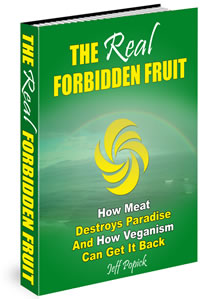 The main point of this book is a brilliant exegesis of the story of the Fall: The forbidden fruit of Eden in Genesis, the fruit of the Knowledge of Good and Evil, was not from a tree. It was not an apple or pomegranate enchanted by some Hogwartsian spell to increase the eater's knowledge. Rather, it must be understood as a symbol for the eating of animal flesh. Since such food is obtained by killing an innocent--an evil act--it confers a knowledge of evil. The only way to understand evil is to commit evil. It also confers, indirectly, a knowledge of good, since one who does not know what evil is cannot understand what good is either.
The main point of this book is a brilliant exegesis of the story of the Fall: The forbidden fruit of Eden in Genesis, the fruit of the Knowledge of Good and Evil, was not from a tree. It was not an apple or pomegranate enchanted by some Hogwartsian spell to increase the eater's knowledge. Rather, it must be understood as a symbol for the eating of animal flesh. Since such food is obtained by killing an innocent--an evil act--it confers a knowledge of evil. The only way to understand evil is to commit evil. It also confers, indirectly, a knowledge of good, since one who does not know what evil is cannot understand what good is either.
To the excellent arguments for this interpretation that Popick presents, I would like to add one more: Whether the serpent of the story is the "most subtle" of beasts or not, he certainly is a most carnivorous one. If Mr. Serpent taught our ancestors to eat forbidden food, he taught it by example. And nothing he eats is vegan or kosher.
Surprisingly, Mr. Popick does not present his main point until page 139, more than halfway through the book. Perhaps he wanted to make the point first of how pernicious flesh-eating is. This he does, but unfortunately he comes across as overzealous, not to say shrill. He refers to omnivores and carnivores as "murderers" and "sociopaths." Although victimized beasts, could they talk, might justifiably use such language, for a human animal to hurl such words at flesh-eaters is not very likely to win them to the cause! Furthermore, in four instances (pages 39, 46, 79, 108) he uses words printed all in capitals, with exclamation marks. This is the equivalent of shouting at the reader, verbal violence that is more likely to enrage or frighten off the other. Straightforward presentations of fact (together with appeals to basic decency) are more effective.
At times he does just this. A good example is the comparison on pages 48 and 49 of the anatomy and physiology of carnivores, herbivores and humans. Of 20 crucial points, humans are closer to the herbivores in 19 cases (the one exception being simple stomachs versus the quadruple stomachs of the grass-eating ruminants). This is very persuasive. He might even have carried it further, expanding the comparison to include the omnivores - bear, chimpanzee, mouse, pig, racoon, rat; and the fructivores, such as the parrot and the monkey. (The lastnamed creatures, placed by God on trees to eat the fruit, actually obeyed the divine mandate and stayed there.)
In sum, I agree wholeheartedly with Mr. Popick's brilliant thesis, but I wish he had conveyed what he has to say in a more restrained manner. I intend to present his ideas in other contexts, giving him full credit, of course, but softening the lethal edges.
--Benjamin Urrutia
Film Review: A Sacred Duty
A Sacred Duty: Applying Jewish Values to Help Heal the World. Produced by Lionel Friedberg. Underwritten by the Jewish Vegetarians of North America (JVNA). Available free of cost from www.jewishveg.com
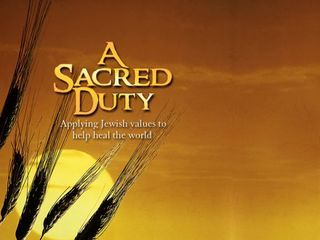 This hour-length documentary, presented by Jewish Vegetarians of North America, vividly addresses the environmental crisis now facing humanity. The film builds the case for action in the face of global warming, water, soil, and air contamination, and destruction of the earth’s ecosystems. It appeals to viewers on the basis of the teachings of the Torah and other Jewish scriptures, as well as commonly-held moral norms.
This hour-length documentary, presented by Jewish Vegetarians of North America, vividly addresses the environmental crisis now facing humanity. The film builds the case for action in the face of global warming, water, soil, and air contamination, and destruction of the earth’s ecosystems. It appeals to viewers on the basis of the teachings of the Torah and other Jewish scriptures, as well as commonly-held moral norms.
Some of the film was shot in Israel, showing the seriousness of environmental problems there and in neighboring countries. It assumes interest in Israel without giving any sign of an anti-Palestinian outlook, and in fact points up a rapprochement between some Israelis and Palestinians, who are working together on creative solutions.
After laying much scientific groundwork for understanding various aspects of the environmental crisis, the film moves into the issue of animal agribusiness, starting with the 2006 United Nations Food and Agriculture Report, Livestock's Long Shadow, which reveals that animal agriculture, and especially methane from cattle, contributes more to global warming than all forms of transportation together. The film urges us to examine our food choices in order to reduce our harmful impact on the planet, to take care of our health, and to live compassionately with our fellow beings, documenting its claims that a plant-based diet addresses these concerns.
There are a number of painful scenes showing the mistreatment of animals in factory farms, scenes which fit appropriately into the overall structure of the film and are necessary to convey the urgent need for change. The film features leading Israeli and American environmentalists, medical authorities, educators, social activists and animal rights experts, as well as Orthodox, Conservative, Reform and Reconstructionist rabbis. The excellent cinematography creates a good balance of talking heads within the rest of the film.
--Kathryn Carpenter
Kathryn "Kate" Carpenter is clerk of the Animal Kinship Committee of Orange Grove Friends Meeting, sponsor of The Peaceable Table. Her Pilgrimage narrative may be found in PT 24, Aug-Sep. 06.
Recipes
La Vegan Piperade au Basilic
(Peppers and Tofu with Basil)
serves 3-4
1 medium yellow or red onion, sliced very thin
2 red sweet peppers, seeded and sliced thin (or use one red and one yellow pepper)
4 T. extra virgin olive oil
3 large fresh tomatoes, peeled, seeded, and chopped
2 large cloves garlic, finely chopped
½ tsp. sea salt
¼ tsp. freshly ground black pepper, or to taste (the flavor should be lively)
1 14-oz. container organic tofu, firm
¼ tsp. turmeric, powdered
Squeeze extra liquid from the tofu prior to adding it to the recipe.
4 large basil leaves, coarsely torn, (or 1 tsp. dry basil leaves, crumbled)
Heat 3 T. olive oil over medium heat in large skillet; add onion and cook until transparent and beginning to turn golden, about 10 minutes; add red peppers, and continue cooking 10 more minutes or until the red pepper is tender but not too soft. Add tomatoes, garlic, salt, and black pepper; bring to a light boil; reduce heat to very low. Cook uncovered until liquid has evaporated. The mixture should be quite thick.
Add remaining 1 T. olive oil and basil to mixture. Crumble tofu and stir into vegetable mixture along with ¼ tsp. turmeric. Remove from heat when tofu has completely heated through. Serve immediately.
This is a robust combination of tofu and vegetables that makes a meal when accompanied by a salad of greens and good crusty bread. It is inspired by a Basque dish from the French Pyrenees called La Piperade au Basilic.
--- Angela Suarez
Aillade de Seitan
(Seitan and Garlic Stew)
serves 4 - 6
1 ½ lbs. Seitan, medium light, cut in 1 ½” pieces or cubes
3 - 4 T. extra virgin olive oil
2 T. bread crumbs
½ cup dry white wine
1 lb. fresh tomatoes, peeled and coarsely chopped
16 cloves garlic, whole and peeled
sea salt, to taste
freshly ground black pepper, to taste
1 - 2 cups vegetable broth, if needed to maintain enough liquid for the stew
1 lb. pasta such as Rombi (small lasagne style noodles), cooked al dente
extra virgin olive oil, for drizzling
In a large heavy deep skillet or large cooking pot, brown Seitan in olive oil. Remove Seitan from skillet and keep warm. Add bread crumbs to the same pan; stir well. Add wine and deglaze the pan. Add tomatoes, garlic and ¼ tsp. sea salt. Cook for 10 minutes. Add Seitan and any juices produced during sautéing. Reduce heat to very low and cook for 45 minutes. Add a little vegetable broth as needed to maintain stew consistency.
Serve stew over pasta. Drizzle with olive oil as desired.
-- Angela Suarez
Seitan Medium Style – Basic Recipe
makes about 1 - 1 ½ pounds Seitan
2 cups vital wheat gluten
2 T. nutritional yeast
½ tsp. onion powder
¼ tsp. garlic powder
¼ tsp. powdered rosemary
2 T. Tamari
2 T. tomato paste
1 T. red wine vinegar
2 tsp. evaporated cane juice (organic sugar)
1 ½ cups spring water
Place all the ingredients in a food processor-- Process until it forms a dough ball. It can then be cut into pieces and simmered in a cooking broth (recipe follows for Cooking Liquid: Seitan Medium Style) for about 1 ½ hours.
Cut in rectangular pieces. Seitan does expand as it cooks; be careful not to make pieces too large.
I do not like referring to vegan food by names applied to animal flesh; therefore I name my Seitan varieties by their appearance rather than as alternatives to "meat." This recipe is very tasty but not overly hearty. It goes well in the Seitan and Garlic Stew recipe above.
Cooking liquid for Seitan Medium Style
4 - 4½ cups water
1 T. onion powder
½ tsp garlic powder
½ tsp. black pepper
1 tsp. paprika
½ tsp. sea salt
1 T. rubbed dried sage
2 bay leaves
2 tsp. organic sugar
1 T. red wine vinegar
1 T. tomato paste
2 T. Tamari
Place all ingredients in a large pot, whisk or stir together to blend. Bring to a boil, then reduce heat and add the Seitan dough. Let simmer about 1 ½ hours. The cooking liquid can be cooled, stored in the refrigerator and used again for your next batch of Seitan.
--Angela Suarez
Veggie Bagels for Companion Dogs
makes about 2 ½ dozen
2 cups organic whole wheat flour
1 cup organic unbleached flour
1 tsp. baking powder
½ tsp. baking soda
2 T. nutritional yeast
¼ tsp. sea salt
2 tsp. dried parsley
½ cup diced vegetable cooked very tender (such as carrots, peas, beets, or spinach)
1 T. safflower oil
1 cup soy milk or spring water
Preheat oven to 350° F. In the bowl of a food processor, combine dry ingredients. Pulse a couple of times to blend. Add vegetables, safflower oil, and soy milk. Process until a ball of dough forms. Remove from bowl of food processor. Shape into balls 1 - 2 inches in diameter. Using a dowel, chopstick or handle of a wooden spoon, poke a hole in each bagel. Place on a well oiled baking sheet. Brush each bagel with safflower oil. Bake 30 minutes. Remove and cool on racks. Store in airtight containers after completely cool.
These are a delicious way to supplement companion animals’ diets with vegetables.
-- Angela Suarez
My Pilgrimage: The Story of How I Became Vegetarian
by Nathan Runkle

I became a vegetarian when I was 11 years old, after picking up and taking to heart the content of a flyer.
Growing up on a small farm off the back country roads of Saint Paris, Ohio, I was surrounded by animals since the day I was born. Like most children, I grew up with a natural affinity for animals, and over time I developed strong bonds and friendships with our family’s dogs and cats with whom we shared our home.
However, it wasn’t until later in life that I made the connection between my beloved dog, Sadie, whom I would do anything to protect from abuse or discomfort, and the nameless pigs, cows, and chickens who were transformed from living, feeling individuals to consumable corpses known to me only as breakfast, lunch, and dinner. I came to understand that every time I sat down to eat I was making a choice that would not only affect my own health, but have a profound impact on the lives of animals.
Like most people who adopt a vegetarian diet, at first I was left wondering what and where to eat. Over time, however, I found that there was a whole new world of exciting, healthy, colorful, and flavorful foods to enjoy. I ditched the typical routine of eating greasy hamburgers and fatty fast-food and began to explore the many delicious, cruelty-free vegan alternatives such as grilled veggie burgers, tacos with veggie “sausage,” frozen non-dairy “ice creams,” and sweet rice, almond, and soy milks over morning cereal.
In addition to replacing my favorite animal-based foods with plant-based alternatives, I began to explore meals from different nationalities and found that many Chinese, Indian, Thai, and Middle Eastern dishes were vegetarian. I now know that being a vegetarian is as simple as choosing your dinner from a different section of the menu and shopping in a different aisle of the grocery store.
Though the animals were my initial reason for eliminating meat, dairy and eggs from my diet, the health benefits of my choice were soon apparent. Coming from a family plagued with cancer and heart disease, which drastically cut short the lives of both my mother and grandfather, I was all too familiar with the effect diet can have on one’s health.
The fruits, vegetables, beans, and whole grains my diet now revolved around made me feel healthier and gave me more energy than ever before. My 57 year old father, a born skeptic, took notice of the undeniable improvements in my health and soon jumped on the veggie bandwagon. He amazed his doctors, and motorcycle pals, when he not only dropped nearly 100 points from his sky-high cholesterol level but also over 25 pounds from his waistline.
In 1999 I founded Mercy For Animals (MFA), a national non-profit animal advocacy organization. Now over 12,000 members strong, MFA works to create a society where animals are treated with the respect and compassion they so rightly deserve. Its basic principles are:
Non-human animals are irreplaceable individuals with morally significant interests and hence rights. This includes the right to live free from unnecessary suffering and exploitation.We are committed to establishing and defending the rights of all animals.
Over 99% of cruelty to animals in the United States occurs at the hands of the meat, dairy, and egg industries - which confine, mutilate, and slaughter over 9 billion animals each year. As such, MFA primarily focuses on farmed animal advocacy and promoting cruelty-free food choices.
We aim to be a voice for animals through proactive consumer education and advertising campaigns, research and undercover investigations, rescues, working with news media, and grassroots activism.
Nathan Runkle is the founder and executive director of Mercy for Animals, www.mercyforanimals.org
Pioneer: Richard "Dick" Gregory, 1932 -
 Dick Gregory, known to most people as a comedian, is also a profoundly serious and compassionate person. active in causes for both humans and other animals. Already in 1968 the civil rights leader compared humanity’s treatment of animals to the conditions of America’s inner cities:
Dick Gregory, known to most people as a comedian, is also a profoundly serious and compassionate person. active in causes for both humans and other animals. Already in 1968 the civil rights leader compared humanity’s treatment of animals to the conditions of America’s inner cities:
“Animals and humans suffer and die alike. If you had to kill your own hog before you ate [him or her], most likely you would not be able to do it. To hear the hog scream, to see the blood spill, to see the baby being taken away from [his or her] momma, and to see the look of death in the animal’s eye would turn your stomach. So you get the man at the packing house to do the killing for you.
“In like manner, if the wealthy aristocrats who are perpetuating conditions in the ghetto actually heard the screams of ghetto suffering, or saw the slow death of hungry little kids, or witnessed the strangulation of manhood and dignity, they could not continue the killing. But the wealthy are protected from such horror...If you can justify killing to eat meat, you can justify the conditions of the ghetto. I cannot justify either one.”
Gregory credits the Judeo-Christian ethic and the teachings of Dr. Martin Luther King, Jr. with having caused him to become a vegetarian. In 1973, he drew a connection between vegetarianism and nonviolent civil disobedience: ". . . the philosophy of nonviolence, which I learned from Dr. Martin Luther King, Jr. during my involvement in the civil rights movement, was first responsible for my change in diet. I became a vegetarian in 1965. I had been a participant in all of the ‘major’ and most of the ‘minor’ civil rights demonstrations of the early sixties, including the March on Washington and the Selma to Montgomery March.
“Under the leadership of Dr. King, I became totally committed to nonviolence, and I was convinced that nonviolence meant opposition to killing in any form. I felt the commandment ‘Thou shalt not kill’ applied to human beings not only in their dealings with each other—war, lynching, assassination, murder and the like—but in their practice of killing animals for food or sport. Animals and humans suffer and die alike . . .Violence causes the same pain, the same spilling of blood, the same stench of death, the same arrogant, cruel and brutal taking of life.”
In a 1979 interview, Gregory explained: “Because of the civil rights movement, I decided I couldn’t be thoroughly nonviolent and participate in the destruction of animals for my dinner...I didn’t become a vegetarian for health reasons; I became a vegetarian strictly for moral reasons . . . Vegetarianism will definitely become a people’s movement.”
When asked if humans will ultimately have to answer to a Supreme Being for their exploitation of animals, Gregory replied, “I think we answer for that every time we go to the hospital with cancer and other diseases.”
Gregory has also expressed the opinion that the plight of the poor will improve as humans cease to slaughter animals: “I would say that the treatment of animals has something to do with the treatment of people. The Europeans have always regarded their slaves and the people they have colonized as animals.”
Gregory advocates a raw-food vegan diet.
--Vasu Murti
Vasu Murti is the author of They Shall Not Hurt or Destroy:
Animal Rights and Vegetarianism in the Western Religious Tradition
Poetry: John Drinkwater
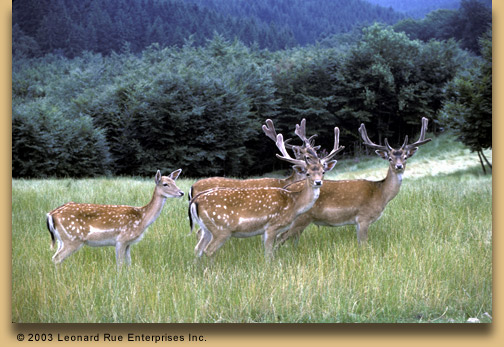
Deer
Shy in their herding dwell the fallow deer.
They are spirits of wild sense. Nobody near
Comes upon their pastures. There a life they live,
Of sufficient beauty, phantom, fugitive,
Treading as in jungles free leopards do,
Printless as evelight, instant as dew.
The great kine are patient, and home-coming sheep
Know our bidding. [But] fallow deer keep
Delicate and far their counsels wild,
Never to be folded reconciled
To the spoiling hand as the poor flocks are;
Lightfoot, and swift and unfamiliar,
These you may not hinder, unconfined
Beautiful flocks of the mind.
--John Drinkwater, 1882-1937
The fallow deer, found in both Europe and Asia, has distinctive palmate antlers, and white spots in adulthood as well as infancy.
Credits:
The Peaceable Table is
intended to resume the witness of that excellent vehicle of the Friends
Vegetarian Society of North America, The Friendly
Vegetarian, which appeared quarterly between 1982 and
1995. Following its example, and sometimes borrowing from its
treasures, we publish articles for toe-in-the-water
vegetarians as well as long-term ones, poetry, letters, book
and film reviews, and recipes.
The journal is intended to be
interactive; contributions, including illustrations, are
invited for the next issue. Deadline for the April issue
will be March 29, 2007. Send to graciafay@mac.com
or 10 Krotona Hill, Ojai, CA 93023. We operate primarily
online in order to save trees and labor, but hard copy
is available for interested persons who are not online.
The latter are asked to donate $12 (USD) per year if their means allow. Other
donations to offset the cost of the domain name, server, and
advertising notices are welcome.
Website www.vegetarianfriends.net
Editor: Gracia Fay Ellwood
Book and Film Reviewers: Benjamin Urrutia & Robert Ellwood
Recipe Editor: Angela Suarez
NewsNotes Contributors: Marian Hussenbux & Lorena Mucke
Technical Architect: Richard Scott Lancelot Ellwood

 These avian Quakers came to my attention via a mailing from In Defense of Animals (IDA). Matt Rossell, an IDA coordinator, is involved with other advocates in an effort to save a community of Quakers near the little logging town of Yacolt, Washington. Quakers find the top of utility poles to be good places for nest-building, a practice that unfortunately can lead to power outages and electrical fires. From the viewpoint of Clark Public Utilities (CPU), they were nothing but a danger to the (human) public's safety and comfort. One night last November, the CPU destroyed one of the Quakers' homes and killed three of the residents; the others escaped. According to local activist Nick Peck, a great deal of bad publicity resulted from this act, and CPU has been consulting with Yacolt activists and city authorities to work out a solution. Some of these activists have been providing the homeless parrots with food, and are making platforms not far from the original site, on which the Quakers can build new nests. Outside activists got involved; some offered helpful plans, whereas others, by attacking the CPU with hate e-mail, have made matters more difficult.
These avian Quakers came to my attention via a mailing from In Defense of Animals (IDA). Matt Rossell, an IDA coordinator, is involved with other advocates in an effort to save a community of Quakers near the little logging town of Yacolt, Washington. Quakers find the top of utility poles to be good places for nest-building, a practice that unfortunately can lead to power outages and electrical fires. From the viewpoint of Clark Public Utilities (CPU), they were nothing but a danger to the (human) public's safety and comfort. One night last November, the CPU destroyed one of the Quakers' homes and killed three of the residents; the others escaped. According to local activist Nick Peck, a great deal of bad publicity resulted from this act, and CPU has been consulting with Yacolt activists and city authorities to work out a solution. Some of these activists have been providing the homeless parrots with food, and are making platforms not far from the original site, on which the Quakers can build new nests. Outside activists got involved; some offered helpful plans, whereas others, by attacking the CPU with hate e-mail, have made matters more difficult.  Much as I would enjoy having an avian Quaker to live with me, it will almost surely not happen: because I live in California, because I am not in a position to take in a refugee from a decimated nest, and because I don't want to buy or sell any sentient being, or accept one that has been abducted from her or his family. (A "purchase" that is really ransom from an abusive situation is different.) This is not a rejection of living with animal friends per se, especially in view of the huge numbers, especially of cats and dogs, that are unwanted and unable to provide for themselves in a city setting.
Much as I would enjoy having an avian Quaker to live with me, it will almost surely not happen: because I live in California, because I am not in a position to take in a refugee from a decimated nest, and because I don't want to buy or sell any sentient being, or accept one that has been abducted from her or his family. (A "purchase" that is really ransom from an abusive situation is different.) This is not a rejection of living with animal friends per se, especially in view of the huge numbers, especially of cats and dogs, that are unwanted and unable to provide for themselves in a city setting. 
 The book is the true story of Antonina Zabinski and Jan Zabinski, who were in charge of the Warsaw Zoo during the horrors of the Second World War. It was a very modern and progressive zoo, with many of the animals in moated habitats instead of cages (this was 1939, thus far in advance of New York's Bronx Zoo in 1961); and the Zabinskis, with a deep interest in animals, were ideal leaders.
The book is the true story of Antonina Zabinski and Jan Zabinski, who were in charge of the Warsaw Zoo during the horrors of the Second World War. It was a very modern and progressive zoo, with many of the animals in moated habitats instead of cages (this was 1939, thus far in advance of New York's Bronx Zoo in 1961); and the Zabinskis, with a deep interest in animals, were ideal leaders.  The Zabinskis courageously joined the Resistance against the genocidal invaders, carrying out and assisting acts of compassion and of sabotage. They did what they could to help ease the great suffering of the people in the Warsaw Ghetto: hundreds of thousands cruelly overcrowded into a small portion of the city, and systematically deprived of necessities. They helped about three hundred of them escape (one out of every thousand prisoners), offering some a temporary shelter in the zoo. About a handful of these daring escapes are detailed in the book. Some Ghetto stories are told that really have no connection with the Zabinskis or the zoo, such as the narrative of Dr. Janusz Korczak and the Republic of Children, which nobody with any humanity could hear or read without weeping. But the bulk of the book, as the title suggests, consists of well-told zoo stories that are both fascinating and touching.
The Zabinskis courageously joined the Resistance against the genocidal invaders, carrying out and assisting acts of compassion and of sabotage. They did what they could to help ease the great suffering of the people in the Warsaw Ghetto: hundreds of thousands cruelly overcrowded into a small portion of the city, and systematically deprived of necessities. They helped about three hundred of them escape (one out of every thousand prisoners), offering some a temporary shelter in the zoo. About a handful of these daring escapes are detailed in the book. Some Ghetto stories are told that really have no connection with the Zabinskis or the zoo, such as the narrative of Dr. Janusz Korczak and the Republic of Children, which nobody with any humanity could hear or read without weeping. But the bulk of the book, as the title suggests, consists of well-told zoo stories that are both fascinating and touching.  The main point of this book is a brilliant exegesis of the story of the Fall: The forbidden fruit of Eden in Genesis, the fruit of the Knowledge of Good and Evil, was not from a tree. It was not an apple or pomegranate enchanted by some Hogwartsian spell to increase the eater's knowledge. Rather, it must be understood as a symbol for the eating of animal flesh. Since such food is obtained by killing an innocent--an evil act--it confers a knowledge of evil. The only way to understand evil is to commit evil. It also confers, indirectly, a knowledge of good, since one who does not know what evil is cannot understand what good is either.
The main point of this book is a brilliant exegesis of the story of the Fall: The forbidden fruit of Eden in Genesis, the fruit of the Knowledge of Good and Evil, was not from a tree. It was not an apple or pomegranate enchanted by some Hogwartsian spell to increase the eater's knowledge. Rather, it must be understood as a symbol for the eating of animal flesh. Since such food is obtained by killing an innocent--an evil act--it confers a knowledge of evil. The only way to understand evil is to commit evil. It also confers, indirectly, a knowledge of good, since one who does not know what evil is cannot understand what good is either. This hour-length documentary, presented by Jewish Vegetarians of North America, vividly addresses the environmental crisis now facing humanity. The film builds the case for action in the face of global warming, water, soil, and air contamination, and destruction of the earth’s ecosystems. It appeals to viewers on the basis of the teachings of the Torah and other Jewish scriptures, as well as commonly-held moral norms.
This hour-length documentary, presented by Jewish Vegetarians of North America, vividly addresses the environmental crisis now facing humanity. The film builds the case for action in the face of global warming, water, soil, and air contamination, and destruction of the earth’s ecosystems. It appeals to viewers on the basis of the teachings of the Torah and other Jewish scriptures, as well as commonly-held moral norms.
 Dick Gregory, known to most people as a comedian, is also a profoundly serious and compassionate person. active in causes for both humans and other animals. Already in 1968 the civil rights leader compared humanity’s treatment of animals to the conditions of America’s inner cities:
Dick Gregory, known to most people as a comedian, is also a profoundly serious and compassionate person. active in causes for both humans and other animals. Already in 1968 the civil rights leader compared humanity’s treatment of animals to the conditions of America’s inner cities: